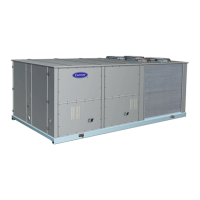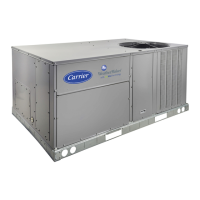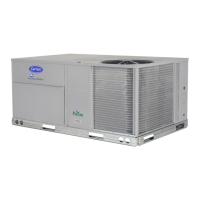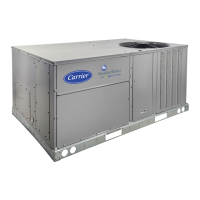54
Finally, the desired capacity is calculated:
Staged Gas Capacity Calculation = “P + D” + old Staged Gas
Capacity Calculation
NOTE: The PID values should not be modified without approval
from Carrier.
Staged Gas Heat Staging
Different unit sizes will control heat stages differently based on
the amount of heating capacity included. These staging pat-
terns are selected based on the model number. The selection of
a set of staging patterns is controlled via the heat stage type
configuration parameter (HT.ST). As the heating capacity rises
and falls based on demand, the staged gas control logic will
stage the heat relay patterns up and down, respectively. The
Heat Stage Type configuration selects one of 4 staging patterns
that the stage gas control will use. In addition to the staging
patterns, the capacity for each stage is also determined by the
staged gas heating PID control. Therefore, choosing the heat
relay outputs is a function of the capacity desired, the heat
staging patterns based on the heat stage type (HT.ST) and the
capacity presented by each staging pattern. As the staged gas
control desired capacity rises, it is continually checked against
the capacity of the next staging pattern.
When the desired capacity is greater than or equal to the capacity
of the next staging pattern, the next heat stage is selected (Run
Status
VIEW
HT.ST = Run Status
VIEW
HT.ST +
1). Similarly, as the capacity of the control drops, the desired ca-
pacity is continually checked against the next lower stage. When
the desired capacity is less than or equal to the next lower staging
pattern, the next lower heat stage pattern is selected (Run Status
VIEW
HT.ST = Run Status
VIEW
HT.ST - 1). The
first two staged gas heat outputs are located on the MBB board
and outputs 3, 4, 5, and 6 are located on the SCB board. These out-
puts are used to produce 5 to 11 stages as shown in Table 53. The
heat stage selected (Run Status
VIEW
HT.ST) is clamped
between 0 and the maximum number of stages possible (Run Sta-
tus
VIEW
H.MAX) for the chosen set of staging patterns.
See Tables 53-57.
Table 53 — Staged Gas Heat — 48A Units
Table 54 — Staged Gas Heat Control Steps (Configuration
HEAT
SG.CF
HT.ST = 1)
Table 55 — Staged Gas Heat Control Steps (Configuration
HEAT
SG.CT
HT.ST = 2)
IMPORTANT: When gas or electric heat is used in a VAV
application with third party terminals, the HIR relay output
must be connected to the VAV terminals in the system in or-
der to enforce a minimum heating airflow rate. The installer
is responsible to ensure the total minimum heating cfm is not
below limits set for the equipment. Failure to do so will result
in limit switch tripping and may void warranty.
UNIT SIZE HEAT CAPACITY
UNIT MODEL NO.
POSITION NO. 5
Configuration
HEAT
SG.CF
HT.ST
ENTRY VALUE
020-030
Low S 1 = 5 STAGE
High T 2 = 7 STAGE
035-050
Low S 1 = 5 STAGE
High T 1 = 5 STAGE
060
Low S 4 = 11 STAGE
High T 3 = 9 STAGE
STAGE
RELAY OUTPUT
CAPACITY
%
Heat 1 Heat 2 Heat 3 Heat 4 Heat 5 Heat 6
MBB-RLY8 MBB-RLY7 SCB-RLY1 SCB-RLY2 SCB-RLY3 SCB-RLY4
IGC1 MGV1 IGC2 MGV2 IGC3 MGV3
0 OFFOFFOFFOFFOFFOFF 0
1 ON OFF OFF OFF OFF OFF 37
2 ON ON OFF OFF OFF OFF 50
3 ON OFF ON OFF OFF OFF 75
4 ON ON ON OFF OFF OFF 87
5 ON ON ON ON OFF OFF 100
STAGE
RELAY OUTPUT
CAPACITY
%
Heat 1 Heat 2 Heat 3 Heat 4 Heat 5 Heat 6
MBB-RLY8 MBB-RLY7 SCB-RLY1 SCB-RLY2 SCB-RLY3 SCB-RLY4
IGC1 MGV1 IGC2 MGV2 IGC3 MGV3
0 OFFOFFOFFOFFOFFOFF 0
1 ON OFF OFF OFF OFF OFF 25
2 ON ON OFF OFF OFF OFF 33
3 OFF OFF ON OFF OFF OFF 50
4 OFF OFF ON ON OFF OFF 67
5 ON OFF ON OFF OFF OFF 75
6 ON ON ON OFF OFF OFF 83
7 ON ON ON ON OFF OFF 100

